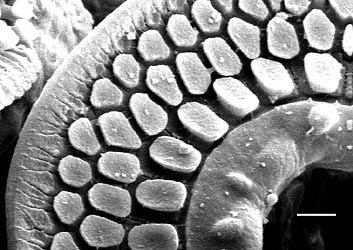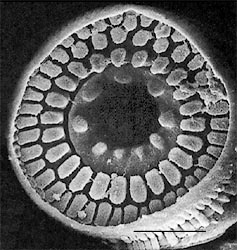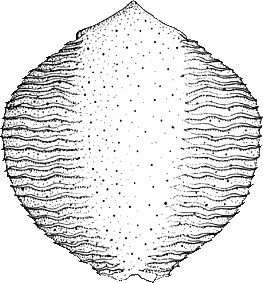- Arms
- Arm formula: IV=II>I=III.
- Arm IV 50% of ML.
- Suckers of arms I-III in 2 series proximally and up to 8-10 series in mid-arm portion (photograph on right).
- Arms II suckers in up to 12-14 series in distally portion.
 Click on an image to view larger version & data in a new window
Click on an image to view larger version & data in a new window
Figure.Scanning electron micrograph (SEM) of the mid-region of arm I, paratype, immature female, 55 mm ML. - Inner sucker rings with 5-6 blunt, rounded teeth (photograph below, left).
- Outer sucker rings with 3 concentric rings of polygonal plates surrounded by a ring of smaller and more narrow plates (photographs below).
 Click on an image to view larger version & data in a new window
Click on an image to view larger version & data in a new window
 Click on an image to view larger version & data in a new window
Click on an image to view larger version & data in a new window
Figure. Left - SEM of arm sucker, paratype, immature female, 55 mm ML. Right - Same sucker, higher magnification. Bar = 10 microns.
- Tentacular club
- Club with six sucker in transverse row at proximal end, 16-20 suckers at mid-club, then decreasing number of suckers toward tip.
- Club length 30% of ML.
- Club slightly expanded.
 Click on an image to view larger version & data in a new window
Click on an image to view larger version & data in a new window
Figure. Oral view of middle region of club, SEM, 55 mm ML. Bar = 300 microns. - Inner sucker ring with about 9 blunt, rounded teeth.
- Outer ring with two concentric rings composed of elongate polygonal plates.
 Click on an image to view larger version & data in a new window
Click on an image to view larger version & data in a new window
 Click on an image to view larger version & data in a new window
Click on an image to view larger version & data in a new window
Figure. Left - Oral view of club sucker, 55 mm ML; bar = 30 microns. Right - Same club sucker, enlarged; bar = 10 microns.
- Buccal crown
- 16-18 suckers, in 2-3 series, on each buccal support.
- Mantle
- Width 43% of ML.
- Occipital region
- Occipital crest prominent.
- 3 occipital folds present.
- Olfactory organ at base of Occipital fold I.
- Fins
- Fin length about 97% of lateral ML at 12 mm ML and 99% at larger sizes.
- Width across fins and mantle about 95% of ML.
- Length of longest fin ribs: 31-40% of ML.
- Each fin with 28 muscular ribs.
 Click on an image to view larger version & data in a new window
Click on an image to view larger version & data in a new window Figure. Dorsal view of fins and mantle, holotype.
Figure. Dorsal view of fins and mantle, holotype.
- Gladius
- Spermatophore
- Measurements
| Squid | ZMH 2778 | ZMH 2780a | ZMH 2779 | ZMH 2780b |
| Sex | Imm. M. | Imm. M. | Imm. F. | Juvnile |
| ML, mm | 65 | 63 | 55 | 12 |
| MW, %ML | 43.8 | 31.7 | 43.6 | 58.3 |
| Fin L, %Lat. ML | 97.6 | 95 | 96.8 | 97.9 |
| Fin W, %ML | 107.6 | - | 109 | 250 |
| Arm I, %ML | 47.6 | 44.4 | 52.7 | 45.8 |
| Arm II, %ML | 36.9 | 47.6 | 60.9 | 58.3 |
| Arm III, %ML | 47.6 | 49.2 | 47.2 | 50 |
| Arm IV, %ML | 36.9 | 44.6 | 58.1 | 56 |
| Club L, %ML | 30 | - | 32 | 29 |
| Fin Rib L, %ML | 38 | - | 40 | 31 |
| Gladius W, %ML | 18.5 | 18.1 | - | - |
Table of measurements modified from Salcedo-Vargas and Guerrero-Kommritz, 2000.






 Go to quick links
Go to quick search
Go to navigation for this section of the ToL site
Go to detailed links for the ToL site
Go to quick links
Go to quick search
Go to navigation for this section of the ToL site
Go to detailed links for the ToL site